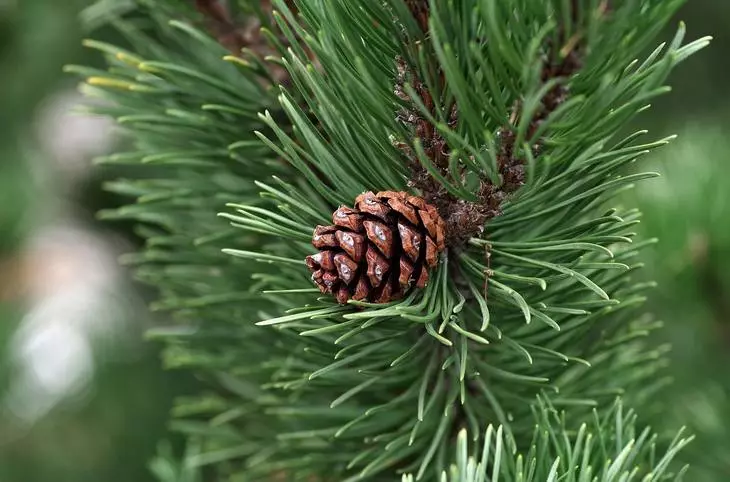
Under the word "conifer" means a wide list of evergreen trees, which includes several species that can be recognized on various characteristics, including needles, cones and bark.
In order not to confuse ate with other conifers, it is enough to know that the needles are located on the real pines and are attached to branches of two groups (red pine group), three (yellow pine group) or five (white pine group) needles per group.
Heri and fir needles are attached individually to the branches.
The pine needles are longer than other relatives, and the needles of pine and fir, as a rule, are softer affect our fingers than the needles of ate - the same spiny.
The needles of the fir usually looks as if she grows on the side, giving the whole branch to a flat look, while the needles of spruce is located around the branch.
Pluses of mulchings
You probably heard the opinion that the needles are too acidic for plant roots. At the same time, forest samples usually lead as an example, in which there is practically nothing grows under coniferous trees.
In fact, the growth of flowers or shrubs is prevented not super-acid due to needles soil, but a heavy shadow, discarded with wood, and strongest competition for water and nutrients. Both shallow and open powerful roots of coniferous trees can also interfere with competitors plant to install their own root system.
Yes, the needles of ate, fir or pines in itself are pretty sour, but the soil under the evergreen plants is not very different from the soil in your garden. This is due to the fact that in almost all soils there is free lime, and the buffer capacity of the soil actively resists the changes in the pH.
Thus, the coniferous mulch will not change the pH at one moment, and in the case of many years of use you can make lime if the soil test shows the acidification, so you can safely try the notorious fashionable mulching "conifer straw".
1. Easy needles and convenient for collecting. This is naturally a renewable resource.
A big plus, the needles rarely brings with them the seeds of weeds. In addition, the needles block sunlight on the seeds that are already in the soil, without giving them germination.
2. The pine needles decompose very slowly, so it does not need to be changed so often as another mulch. As soon as the needles settles, very few needles will be washed away with a torrential rain. They form a loose rug and remain in place.
In this regard, the "pine hitch" is ideal for the fight against the erosion of the soil in the plots. Long pine needles tend to connect firmly, forming a reliable coating. If there is a slope with erosion problems, where the other mulch is washed off with rain or blown away by the wind, try using long pine needles.
3. The needles of conifers soften the temperature of the soil in summer and prevent freezing in winter and bulging the roots from the ground. They are great for perennial plants of all kinds, including apple trees, roses and raspberries.
In the fall, add 7-10 cm of coniferous mulch into the rolling circle, which will protect against sudden and sharp temperature drops and will allow plant roots to "breathe" without spontaneous. In addition, the ringer and mole mouse do not complain about coniferous needles because of the smell.
And again make a bet on pine. Because of its shape and hardness, pine needles do not fit too tight. This means that the root plant system is less likely to be exposed to the deficiency of oxygen and rotting, which sometimes occurs under thick layers of the crust or leaves. But do not forget that the thickness of the layer over 10 cm will create the effect of a turtle shell, not passing water. Therefore, 10 cm is more than enough.
MinusesIn the summer, especially, in the heat it is necessary to ensure that it remains slightly wet and not post the sources of fire.
If you do not cover the soil completely, some weeds will remain, and the nuts on the needle is not particularly pleasant. Although it looks easy and fluffy, the needle is sharp.
When the tracks are sprinkled, this circumstance also need to keep in mind, especially if the children love to run barefoot. After you sprinkled the tracks, you need to walk several times so that the needles are rambling, and even better to skip it through the shredder. Nobody want to go to the traumapunk and urgently make vaccinations from the tetanus.
If you intend to send the served "coniferous straw" to compost, know that coniferous needles are very slowly destroyed. So, the needles of pine has a wax flare, which interferes with bacteria and mushrooms to destroy it. Low pH needle pine suppresses microorganisms in a compost and highly slows down the process of ripening organic feeding.
In order to avoid the "brand" of the compost, use only aged needle that has worked for a mulch for one, or even several seasons, and pre-pass on a muluine melting. The smaller and older than the needle, the faster they decompose.
General Rule: Do not add more than 10 percent of needles to a compost bunch.
